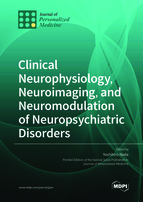Clinical Neurophysiology, Neuroimaging, and Neuromodulation of Neuropsychiatric Disorders
A special issue of Journal of Personalized Medicine (ISSN 2075-4426). This special issue belongs to the section "Methodology, Drug and Device Discovery".
Deadline for manuscript submissions: closed (20 May 2021) | Viewed by 60438
Special Issue Editor
Interests: neuroplasticity; neuromodulation; neurophysiology; TMS; EEG; TMS-EEG; TMS-EMG; MRI; MRS; omics; neuroinformatics; database
Special Issues, Collections and Topics in MDPI journals
Special Issue Information
Dear Colleagues,
Ninety years have passed since Dr. Hans Berger first reported the electrical activity of the human brain in 1929, and, in recent years, as suggested by Dr. György Buzsáki, such ideas as "Without the rhythm of the brain, the mind is not born" and "The brain is a device that predicts, and it is the rhythm of the brain that produces predictive ability" have come to be accepted. Furthermore, recent advances in neuroimaging technology, including EEG, have made it possible to visualize various brain activities. In addition, research on neuromodulation, as an intervention for brain dynamics, the underlying neurophysiological basis of the brain, was rapidly accelerated by the development of TMS in 1985 by Dr. Anthony Barker. On the other hand, as a trend in the field of psychiatry in recent years, the concept of precision medicine has become important to elucidating mental disorders as well as to developing new therapeutic strategies. Research in these areas is progressing rapidly, and new knowledge is being accumulated every day.
This Special Issue aims to present cutting-edge research in Clinical Neurophysiology, Neuroimaging, and Neuromodulation. We welcome original research papers, methodology papers, and review papers describing the use of the latest brain science approaches in the above fields, especially those that incorporate the concept of precision medicine.
Dr. Yoshihiro Noda
Guest Editor
Manuscript Submission Information
Manuscripts should be submitted online at www.mdpi.com by registering and logging in to this website. Once you are registered, click here to go to the submission form. Manuscripts can be submitted until the deadline. All submissions that pass pre-check are peer-reviewed. Accepted papers will be published continuously in the journal (as soon as accepted) and will be listed together on the special issue website. Research articles, review articles as well as short communications are invited. For planned papers, a title and short abstract (about 100 words) can be sent to the Editorial Office for announcement on this website.
Submitted manuscripts should not have been published previously, nor be under consideration for publication elsewhere (except conference proceedings papers). All manuscripts are thoroughly refereed through a single-blind peer-review process. A guide for authors and other relevant information for submission of manuscripts is available on the Instructions for Authors page. Journal of Personalized Medicine is an international peer-reviewed open access monthly journal published by MDPI.
Please visit the Instructions for Authors page before submitting a manuscript. The Article Processing Charge (APC) for publication in this open access journal is 2600 CHF (Swiss Francs). Submitted papers should be well formatted and use good English. Authors may use MDPI's English editing service prior to publication or during author revisions.
Keywords
- EEG
- rTMS
- TMS–EEG
- neuromodulation
- precision medicine







